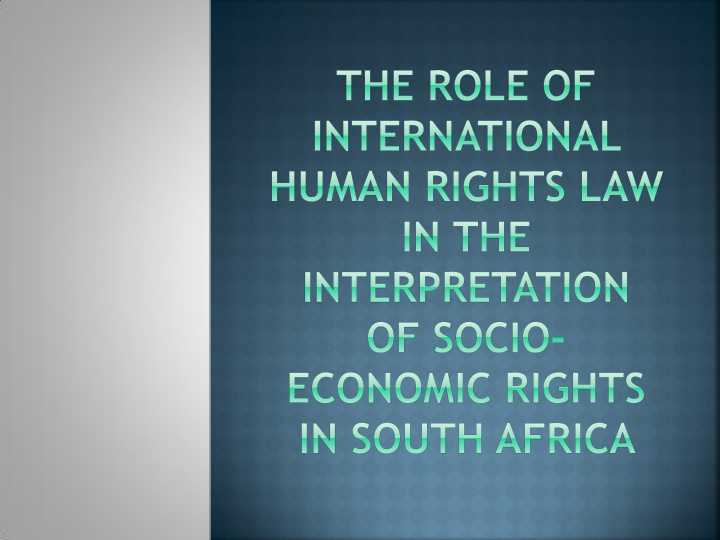



231 International agreements (1) The negotiating and signing of all international agreements is the responsibility of the national executive. (2) An international agreement binds the Republic only after it has been approved by resolution in both the National Assembly and the National Council of Provinces, unless it is an agreement referred to in subsection (3). (3) An international agreement of a technical, administrative or executive nature, or an agreement which does not require either ratification or accession, entered into by the national executive, binds the Republic without approval by the National Assembly and the National Council of Provinces, but must be tabled in the Assembly and the Council within a reasonable time. (4) Any international agreement becomes law in the Republic when it is enacted into law by national legislation; but a self-executing provision of an agreement that has been approved by Parliament is law in the Republic unless it is inconsistent with the Constitution or an Act of Parliament. (5) The Republic is bound by international agreements which were binding on the Republic when this Constitution took effect.
Section 232 Customary international law is law in the Republic unless it is inconsistent with the Constitution or an Act of Parliament. Section 39 (1)When interpreting the Bill of Rights, every court tribunal or forum (b) must consider international law
233 Application of international law When interpreting any legislation, every court must prefer any reasonable interpretation of the legislation that is consistent with international law over any alternative interpretation that is inconsistent with international law.
Have South African Courts invoked international human rights law within the context of s 35(1) and s 231 of the IC and section s39(1)(b), S231 and s232 of the FC optimally in the interpretation of socio-economic rights?
The development of international human rights law Sources of international law Treaties and Conventions Custom General Principles of law recognized by civilized nations Judicial decisions and the teachings of the most highly qualified publicists of the various nations Monism/Dualism debate
International Charters and Treaties relevant to the protection of Socio-economic rights The Universal Declaration of Human Rights United Nations Charter International treaties created under the auspices of the United Nations Relevant regional instruments and systems The African Human Rights system The European Human Rights system Inter-American Human Rights system Customary international law
In 1986, the SA Law Commission was instructed to investigate the prospect of affording group rights constitutional protection and stated that : “In practical and realistic terms it cannot be envisaged that human rights norms as enshrined in international law can to any extent play a part – let alone a significant part – in the decisions of our courts. The salvation of the protection of group and individual rights in South Africa does not lie in the hope that our courts will apply the norms of international law in this regard. ”
Public international law and the early South African Legal Order The monism / Dualism debate South Africa’s domestic policies under Apartheid and international human rights The role of the judiciary in the employment of : international treaties Customary international law Common law The protection of human rights by the South African Courts
Chapter 2 cont. International law and the Interim Constitution Invoking section 35 Section 231 The Final Constitution
The development of trends in the Court’s consideration of public international law in the interpretation of the Bill of Rights International law as interpretive framework Conflating the distinction between public international law and foreign law
Section 35(1) of the IC states: In interpreting the provisions of this Chapter a court of law shall promote the values which underlie an open and democratic society based on freedom and equality and shall, where applicable, have regard to public international law applicable to the protection of the rights entrenched in this Chapter, and may have regard to comparable foreign case law . Section 39 (1) When interpreting the Bill of Rights, a court, tribunal or forum- (a)Must promote the values that underlie an open and democratic society based on human dignity, equality and freedom; (b) Must consider international law; and (c) May consider foreign law.”
Enjoining courts to consider both foreign law and public international law, making the consideration of both sources mandatory Courts to only have regard to public international law and foreign law Consequences: The neglect of public international law and the disproportionate reliance on foreign law
Conflating the distinction between public international law and foreign law The relevance of structure in maintaining the divide misrepresentation The neglect of public international law and the disproportionate reliance on foreign law within the context of s35(1) of the IC The neglect of public international law binding upon South Africa in terms of s 231 of the IC & FC The relationship between s 233 and s 39(1)(b) of the FC The role of public international law in the limitation of rights Rationalizing the trends
The incorporation of international socio-economic rights law into the South African Legal order The role of international human rights in the drafting of socio-economic rights entrenched in the Bill of Rights The significance of international human rights law in the interpretation of socio-economic rights The development of reasonableness review International instruments International Covenant on Economic, Social and Cultural Rights The Concept of minimum core obligations The Optional Protocol Reasonableness Review
The European Regional System The European Convention on Human Rights The European Social Charter The Inter-American System The American Declaration The American Convention Protocol of San Salvador The African Regional System African Charter The African Children’s Charter Women’s Protocol Over-Arching trends in the reliance on international law for the interpretation of socio- economic rights
“Best case” illustrations of foreign jurisdictions which have invoked international human rights law in the interpretation of socio-economic rights India Nigeria Colombia

Recommend
More recommend